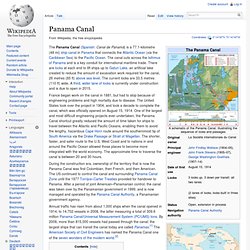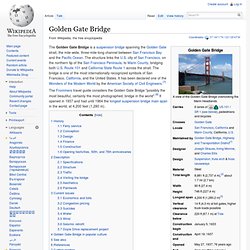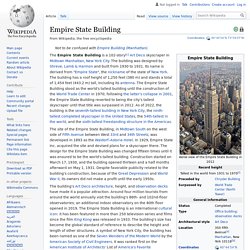

Panama Canal. Location of Panama between Pacific (bottom) and Caribbean (top), with canal at top center The Panama Canal (Spanish: Canal de Panamá) is a 77.1-kilometre (48 mi) ship canal in Panama that connects the Atlantic Ocean (via the Caribbean Sea) to the Pacific Ocean.

The canal cuts across the Isthmus of Panama and is a key conduit for international maritime trade. There are locks at each end to lift ships up to Gatun Lake, an artificial lake created to reduce the amount of excavation work required for the canal, 26 metres (85 ft) above sea level. The current locks are 33.5 metres (110 ft) wide. A third, wider lane of locks is currently under construction and is due to open in 2015. France began work on the canal in 1881, but had to stop because of engineering problems and high mortality due to disease. During the construction era, ownership of the territory that is now the Panama Canal was first Colombian, then French, and then American. History[edit] Early proposals[edit] Ferdinand de Lesseps. Zuiderzee Works. Delta Works. Itaipu Dam. The Itaipu Dam (Guarani: Itaipu, Portuguese: Itaipu, Spanish: Itaipú; Portuguese pronunciation: [itɐjˈpu], locally: [ita.iˈpu], Spanish pronunciation: [itaiˈpu]) is a hydroelectric dam on the Paraná River located on the border between Brazil and Paraguay.

The name "Itaipu" was taken from an isle that existed near the construction site. In the Guaraní language, Itaipu means "the sounding stone". Of the twenty generator units currently installed, ten generate at 50 Hz for Paraguay and ten generate at 60 Hz for Brazil. Golden Gate Bridge. The Golden Gate Bridge is a suspension bridge spanning the Golden Gate strait, the mile-wide, three-mile-long channel between San Francisco Bay and the Pacific Ocean.

The structure links the U.S. city of San Francisco, on the northern tip of the San Francisco Peninsula, to Marin County, bridging both U.S. Route 101 and California State Route 1 across the strait. Empire State Building. The Empire State Building is generally thought of as an American cultural icon.

It is designed in the distinctive Art Deco style and has been named as one of the Seven Wonders of the Modern World by the American Society of Civil Engineers. The building and its street floor interior are designated landmarks of the New York City Landmarks Preservation Commission, and confirmed by the New York City Board of Estimate.[13] It was designated as a National Historic Landmark in 1986.[9][14][15] In 2007, it was ranked number one on the AIA's List of America's Favorite Architecture. History[edit] CN Tower. The CN Tower (French: Tour CN) is a 553.33 m-high (1,815.4 ft) concrete communications and observation tower in Downtown Toronto, Ontario, Canada.[3][6] Built on the former Railway Lands, it was completed in 1976, becoming the world's tallest free-standing structure and world's tallest tower at the time.
It held both records for 34 years until the completion of Burj Khalifa and Canton Tower in 2010. It remains the tallest free-standing structure in the Western Hemisphere, a signature icon of Toronto's skyline, and a symbol of Canada,[7][8] attracting more than two million international visitors annually.[5][9] Its name "CN" originally referred to Canadian National, the railway company that built the tower.
Following the railway's decision to divest non-core freight railway assets, prior to the company's privatization in 1995, it transferred the tower to the Canada Lands Company, a federal Crown corporation responsible for real estate development. History View from CN Tower at night Events. Channel Tunnel. The Channel Tunnel (French: Le tunnel sous la Manche; also referred to as the Chunnel)[2][3] is a 50.5-kilometre (31.4 mi) rail tunnel linking Folkestone, Kent, in the United Kingdom, with Coquelles, Pas-de-Calais, near Calais in northern France, beneath the English Channel at the Strait of Dover.

At its lowest point, it is 75 m (250 ft) deep.[4][5][6] At 37.9 kilometres (23.5 mi), the tunnel has the longest undersea portion of any tunnel in the world, although the Seikan Tunnel in Japan is both longer overall at 53.85 kilometres (33.46 mi) and deeper at 240 metres (790 ft) below sea level.